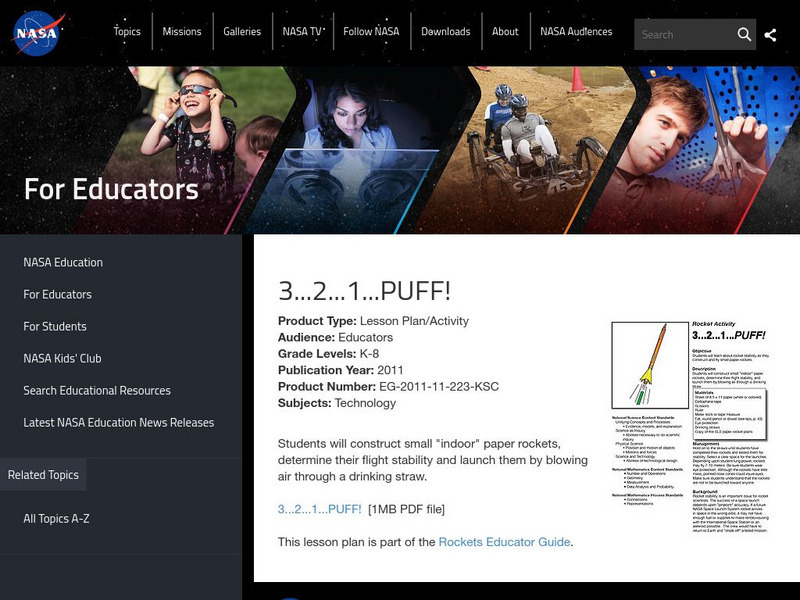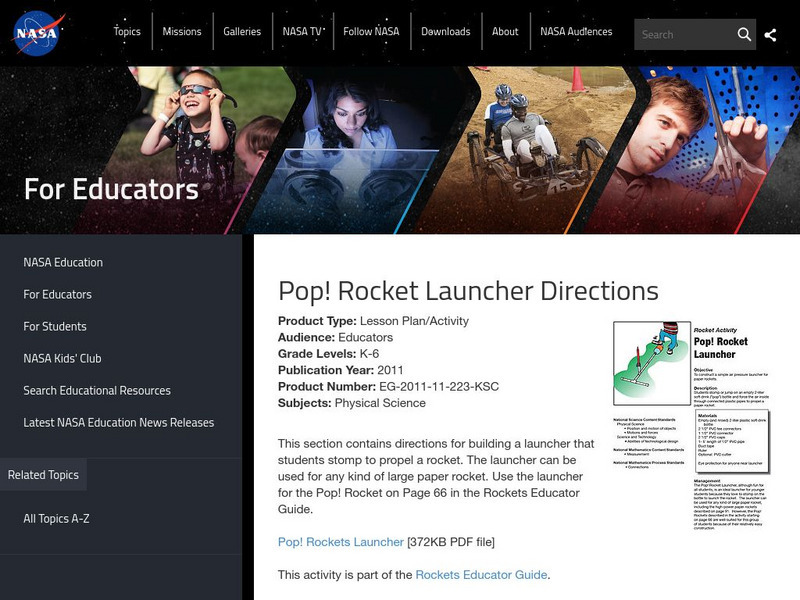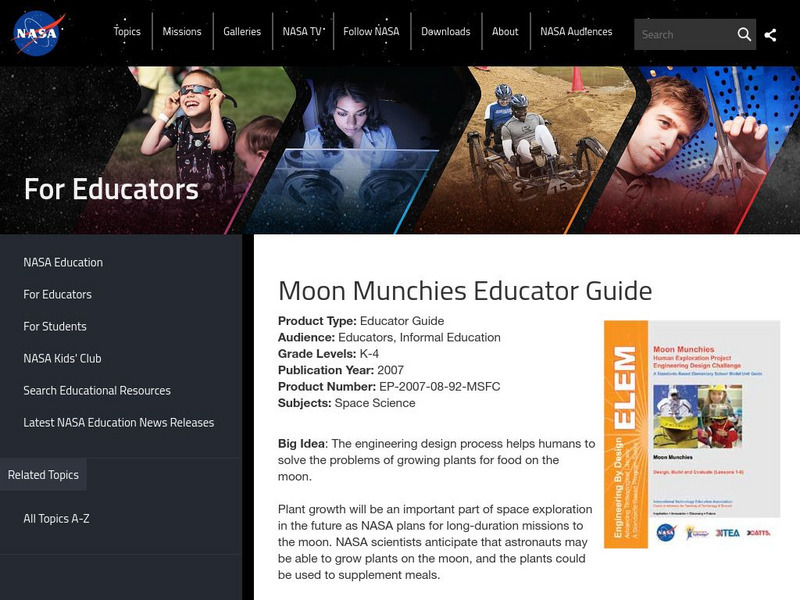Hi, what do you want to do?
NASA
Nasa: Testing a New Spacecraft Material
This is a site from NASA that provides an activity where "You have invented a new material to use for the fuel tanks on the spacecraft. But before you send your new material into the harsh environment of space, you must test it on Earth...
NASA
Nasa: Space Shuttle Glider
Assemble a basic scale model of the space shuttle as a hands-on activity. The activity features math-related concepts such as finding the scale of the paper model and the glide ratio of its flight.
NASA
Nasa: Optics: Light, Color, and Their Uses
Download this Educators Guide to light, color, and their uses. Choose from different activities using lenses, prisms, hidden messages, periscopes, and kaleidoscopes
NASA
Nasa: Rockets Educator Guide: Rocket Races
This lesson allows students to create their own rockets using foam trays and drinking straws that are powered by a balloon. Students will race their rockets on a track and determine why some rockets moved faster than others.
NASA
Nasa: Investigating the Climate System: Clouds
This detailed lesson plan provides six different activities to enhance student knowledge about clouds. Also find links to educator guides about other space topics. Includes PDF (requires Adobe Reader).
NASA
Nasa: Rockets Educator Guide: Applying Newton's Laws
Learn how Newton's Laws apply to rocketry. Discover how rockets work, including the engines and propellants.
NASA
Nasa: Rockets Educator Guide: Pop Can "Hero Engine"
This lesson has students make water propelled engines using pop drink cans. Students will test the effectiveness of the engines and determine anything that affects the action.
NASA
Nasa: Rockets Educator Guide: 3, 2, 1, Puff!
This lesson gives directions for students to construct small, paper rockets that can be launched inside. The students will determine how stable the rocket is and launch them by blowing air through a straw.
NASA
Nasa: Rockets Educator Guide: Newton Car
This lesson gives students direction on how to experiment using gravity and force. Students will make a wooden car and use different forces to make the car propel.
NASA
Nasa: Rockets Educator Guide: Pop! Rocket Launcher
This lesson allows students to construct a rocket launcher that can be used for several different types of rockets. This rocket launcher is propelled by students stomping on a two liter bottle to provide force.
NASA
Nasa: Rockets Educator Guide: Pop! Rockets
This lesson plan allows students to make a rocket with card stock paper. Students will be able to launch the rocket and then discuss the variables affecting the height of each launch.
NASA
Nasa: Rockets Educator Guide: Foam Rocket
This lesson plan shows students how to construct a rocket using pipe insulating foam. Students will investigate the relationship between launch angle and range when launching their rockets powered by rubber bands.
NASA
Nasa: Rockets Educator Guide: Launch Altitude Tracker
This lesson plan allows student to make a launch altitude tracker. Student will use a sighting tube and angle measurements to track the altitude of rockets that are launched.
NASA
Nasa: Rockets Educator Guide: Rocket Wind Tunnel
This lesson's objective is to construct a rocket wind tunnel and have student predict the performance of their rocket. Students will use this rocket wind tunnel to measure and modify parts of the rocket to make it fly higher.
NASA
Nasa: Rockets Educator Guide: Water Rocket Launcher
Follow the directions in the lesson plan to construct a water rocket launcher made from off the shelf hardware and wood.
NASA
Nasa: Exploration: Then and Now: Settlement Lesson
This lesson plan has students examine different land to determine whether settlement is affected by an area's location, soil, and weather.
NASA
Nasa: Exploration: Then and Now: Follow the Water Lesson
The objective of this lesson is for students to learn the location of water and the importance of water to life. Students will learn about osmosis, soil samples, salinity, and more.
NASA
Nasa: X1 Paper Glider Kit
This lesson allows students to build their own paper gliders and change characteristics of the glider to make it fly easier.
NASA
Nasa: Drag, Lesson 4
This video [12:28] shows how Newton's law of motion relates to the drag of an airplane. Watch as an instructor shows how the molecules colliding with the airplane create drag.
NASA
Nasa: The Brain in Space
This educators guide shows students how the body's brain, spinal cord and network of nerves control the activities of animals and humans.
NASA
Nasa: Moon Munchies Educator Guide
This educator guide provides teachers with an outline for the entire Moon Munchies unit. Students will be able to design and build a lunar plant growth chamber using the Engineering Design Process.
NASA
Nasa: Cool Suits Activity
"Which color, black or white, reflect energy?" "Which color absorbs energy better?" Through this activity, students will find the answers to these questions, and they will then be able to relate their findings to the construction of...
NASA
Nasa: 3, 2, 1, Liftoff! Educator Guide
These activities introduce students to the International Space Station and how rockets were vital to its construction. The provided lessons correlate to all subject areas.
NASA
Nasa: Food for Spaceflight Activity
This educator's guide provides teachers with activities to teach students about food during spaceflights. Students will learn about types of food astronauts take on space missions and why these foods are the most suitable for space.




























